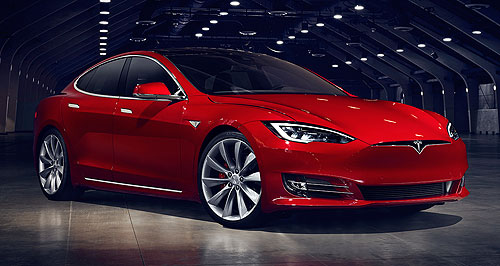Make / Model Search
New models - Tesla - Model STesla brings back entry-level Model SPlugged in: Tesla has reintroduced the base model Model S 60, and in the process lowered the entry price for its large liftback range. Return of Model S 60 lowers entry point to Tesla’s Australian range10 Jun 2016 By TIM ROBSON TESLA has brought back the entry-level Model S 60 to its Australian catalogue after an absence of 14 months in a bid to broaden the appeal of the US electric vehicle-maker Down Under. The 60 spearheaded the brand’s official presence in Australia in late-2014, but a range realignment last year saw the 60 dropped in favour of the more powerful 70. “We’ve heard from a number of people who would like to buy a Model S, but can more easily afford it only at a lower price point,” said Tesla’s senior marketing and communications manager Heath Walker. “To respond to these requests, on Thursday June 9, globally, we're introducing two new variants of Model S.” The 60, which will be offered in both rear- (60) and all-wheel-drive (60D) variants, replaces the now discontinued 70D as the brand’s cheapest car in Australia the rear-driver starts at $100,800 before on-road costs and luxury car tax, and the AWD variant will cost $108,300 before costs. The 60 runs a 285kW rear motor that is limited to 235kW of output by the battery, while 440Nm of torque is instantly available from rest. The 60D has 193kW motors on both the front and rear axles, with outputs of 245kW and 525Nm. The 60 will be compatible with Tesla’s Supercharger network, which can replenish the battery to 80 per cent in about 30 minutes. A wall socket or public charging station can add up to 30km of range per hour, and the Model S is supplied with both a mobile and home charger. The P85D has also disappeared from the Tesla line-up, superseded by the all-wheel-drive 90D and the range-topping P90D. Tesla’s model number designations refer to its battery pack capacity in kilowatt-hours the 60 offers a projected range of 400km, while the 60D can travel 408km before requiring a charge. The 90D, by comparison, can travel more than 550km on a single charge. Performance for the 60 sees a 0-100km/h time of 5.8 seconds and a top speed of 210km/h. Additionally, Model S 60 owners have the option of upgrading to a new 75kWh battery pack – sourced from the forthcoming Model X SUV – for $13,500, which gives both variants 480km of range. The 60 cannot be upgraded with the top-spec 90kWh pack. The S 60 comes standard with a 17-inch touchscreen which controls all of the car’s major functions, satellite navigation with seven years of free map upgrades, keyless entry, WiFi connectivity, reversing camera, rain-sensing wipers, automatic headlights, hands-free Bluetooth, internet radio, powered and heated seats and two USB ports. It’s equipped with stability and traction control, front and side collision avoidance, blind spot monitoring, lane-departure warning, parking sensors and three Isofix seat mounts, along with six air bags. Tesla’s Autopilot system, which adds highway and city autonomous driving functionality, along with the recently added Summon function which allows the Model S to park and unpark itself, is a $3800 option at the time of ordering, or $4500 after delivery. Other options include $3800 for air-sprung suspension, a premium upgrades package that includes, LED lighting, improved air purification, LED foglights, Nappa leather and Alcantara dash accents and a powered tailagate for $4500. Tesla does not provide sales figures for its vehicles, but GoAuto estimates that around 800 cars have been sold since the brand’s Australian operations commenced in 2014.
 Read more20th of May 2016  Tesla Model 3 orders drop by 12,200Share filing reveals 12,200 cancelled Tesla model 3 orders18th of May 2016  Tesla investigates damning reportUnderpaid foreign workers allegedly hired by subcontractor for Tesla paint plantAll new modelsModel S pricing
Motor industry news |
|
||||||||||



 Alfa Romeo
Alfa Romeo Abarth
Abarth Audi
Audi Aston Martin
Aston Martin BMW
BMW Bentley
Bentley Ferrari
Ferrari Chevrolet
Chevrolet Ford
Ford Fiat
Fiat GWM
GWM Foton
Foton Hyundai
Hyundai Honda
Honda Jaguar
Jaguar Isuzu
Isuzu Kia
Kia Jeep
Jeep Land Rover
Land Rover Lamborghini
Lamborghini Maserati
Maserati Lexus
Lexus McLaren
McLaren Mazda
Mazda Mercedes-Benz
Mercedes-Benz Mitsubishi
Mitsubishi Mini
Mini Peugeot
Peugeot Nissan
Nissan Ram
Ram Porsche
Porsche Rolls-Royce
Rolls-Royce Smart
Smart Skoda
Skoda Suzuki
Suzuki Subaru
Subaru Toyota
Toyota Tesla
Tesla Volvo
Volvo Zeekr
Zeekr







Facebook Twitter Instagram